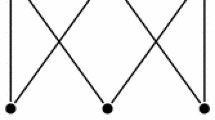Abstract
Despite recent advancements in user-driven social media platforms, tools for studying user behavior patterns and motivations remain primitive. We highlight the voluntary nature of user contributions and that users can choose when (and when not) to contribute to the common media pool. A Game theoretic framework is proposed to study the dynamics of social media networks where contribution costs are individual but gains are common. We model users as rational selfish agents, and consider domain attributes like voluntary participation, virtual reward structure, network effect, and public-sharing to model the dynamics of this interaction. The created model describes the most appropriate contribution strategy from each user’s perspective and also highlights issues like ‘free-rider’ problem and individual rationality leading to irrational (i.e. sub-optimal) group behavior. We also consider the perspective of the system designer who is interested in finding the best incentive mechanisms to influence the selfish end-users so that the overall system utility is maximized. We propose and compare multiple mechanisms (based on optimal bonus payment, social incentive leveraging, and second price auction) to study how a system designer can exploit the selfishness of its users, to design incentive mechanisms which improve the overall task-completion probability and system performance, while possibly still benefiting the individual users.
Access this chapter
Tax calculation will be finalised at checkout
Purchases are for personal use only
Similar content being viewed by others
Notes
- 1.
The use of perceived changes in games to try and influence agent interaction is well studied under hyper-game theory [24].
- 2.
Strictly speaking, system designer needs to provide the lowest cost agent with a bonus that is just a fraction above its cost (i.e. b=c 1+ε). This will make the ‘Do’ strategy dominate for the user. However, in a cooperative setting, it is often considered better to grant a ‘fair share’ of the additional benefit the agent brings to the system by participating. Further still, the extra bonus serves as an implicit signaling mechanism to ensure overall system gains.
References
Dellarocas, C.: Reputation mechanism design in online trading environments with pure moral hazard. Inf. Syst. Res. 16(2), 209–230 (2005)
Diamond, P.A., Mirrlees, J.A.: Optimal taxation and public production II: Tax rules. Am. Econ. Rev. 61(3), 261–278 (1971)
Friedman, E., Halpern, J., Kash, I.: Efficiency and Nash equilibria in a scrip system for p2p networks. In: Proceedings of the 7th ACM Conference on Electronic Commerce. ACM, New York (2006)
Google Image Labeler: http://images.google.com/imagelabeler/, Last accessed: 07/06/2009
Harper, F.M., Li, S.X., Chen, Y., Konstan, J.A.: Social comparisons to motivate contributions to an online community. Persuasive Technology, 4744/2007, 2007
Howe, J.: The rise of crowdsourcing. Wired Mag. 14(6), 1–4 (2006)
Kahneman, D.: Maps of bounded rationality: Psychology for behavioral economics. Am. Econ. Rev. 93(5), 1449–1475 (2003)
Kim, O., Walker, M.: The free rider problem: Experimental evidence. Public Choice 43(1), 3–24 (1984)
Lévy, P.: Collective Intelligence: Mankind’s Emerging World in Cyberspace. Perseus Books, Cambridge (1997)
Maia, M., Almeida, J., Almeida, V.: Identifying user behavior in online social networks. In: SocialNets ’08: Proceedings of the 1st Workshop on Social Network Systems, pp. 1–6 (2008)
Microsoft photo-synth project: http://photosynth.net/, Last accessed: 07/06/2009
New York Times launches ‘citizen journalism’ sites: http://washingtonsquarepark.wordpress.com/2009/03/03/new-york-times-launches-citizen-journalism-sites/, Last accessed: 07/06/2009
Nov, O., Naaman, M., Ye, C.: Motivational, structural, and tenure factors that impact online community photo sharing. In: Proceedings of the Third International AAAI Conference on Weblogs and Social Media (ICWSM 2009). Retrieved November, vol. 13, p. 2009 (2009)
Olson, M.: The Logic of Collective Action: Public Goods and the Theory of Groups. Harvard Univ. Press, Cambridge (1971)
Onnela, J.-P., Reed-Tsochas, F.: Spontaneous emergence of social influence in online systems. Proc. Natl. Acad. Sci. (2010)
Osborne, M.J.: An Introduction to Game Theory. Oxford University Press, Oxford (2003)
Park, J., van der Schaar, M.: A game theoretic analysis of incentives in content production and sharing over peer-to-peer networks. In: IEEE Thematic Meetings on Signal Processing: Signal and Information Processing for Social Networks, 2009
Schelling, T.C.: Micromotives and Macrobehavior. Norton, New York (1978)
Schroer, J., Hertel, G.: Voluntary engagement in an open web-based encyclopedia: Wikipedians and why they do it. Media Psychol. 12(1), 96–120 (2009)
Shirky, C.: Cognitive Surplus: Creativity and Generosity in a Connected Age. Penguin, Baltimore (2010)
Singh, V., Jain, R., Kankanhalli, M.: Motivating contributors in social media networks. In: Proceedings of the first SIGMM Workshop on Social Media, pp. 11–18. ACM, New York (2009)
Sun, L., Vassileva, J.: Social visualization encouraging participation in online communities. In: Groupware: Design, Implementation, and Use, 2006
Terdiman, D.: The Entrepreneur’s Guide to Second Life: Making Money in the Metaverse. Sybex, Berkeley (2007)
Vane, R.: Advances in hypergame theory. In: Workshop on Game Theoretic and Decision Theoretic Agents—Conference on Autonomous Agents and Multi-Agent Systems, 2006
von Ahn, L.: Games with a purpose. Computer 39(6), 92–94 (2006)
Wikipedia: http://www.wikipedia.org
Author information
Authors and Affiliations
Corresponding author
Editor information
Editors and Affiliations
Rights and permissions
Copyright information
© 2011 Springer-Verlag London Limited
About this chapter
Cite this chapter
Singh, V.K., Jain, R., Kankanhalli, M. (2011). Mechanism Design for Incentivizing Social Media Contributions. In: Hoi, S., Luo, J., Boll, S., Xu, D., Jin, R., King, I. (eds) Social Media Modeling and Computing. Springer, London. https://doi.org/10.1007/978-0-85729-436-4_6
Download citation
DOI: https://doi.org/10.1007/978-0-85729-436-4_6
Publisher Name: Springer, London
Print ISBN: 978-0-85729-435-7
Online ISBN: 978-0-85729-436-4
eBook Packages: Computer ScienceComputer Science (R0)




